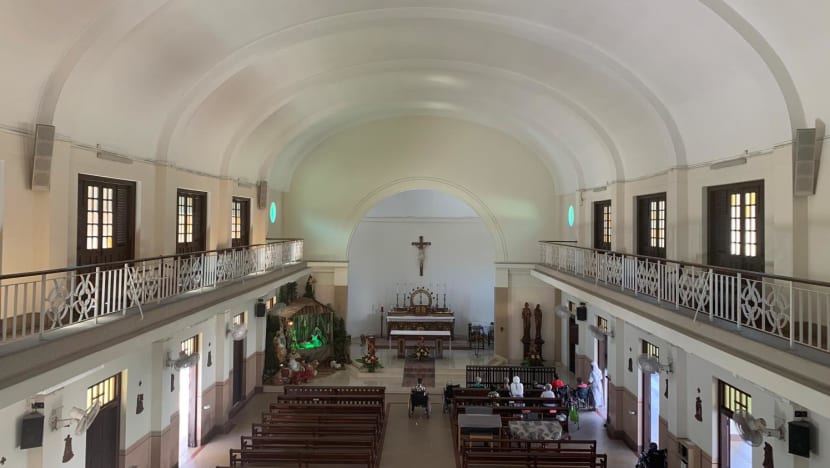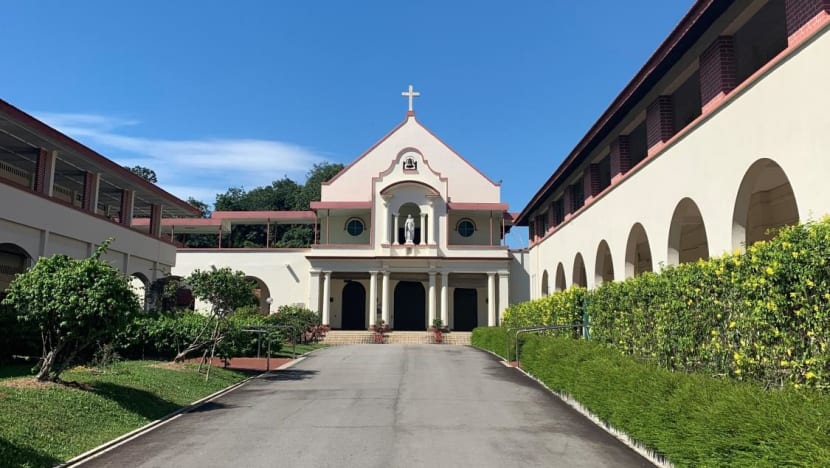Proposed conservation of six buildings and an entrance archway at St Theresa’s Home

The interior of the chapel is designed in a way that gives it depth and focus, which draws the eyes of the worshippers, said URA. (Photo: Urban Redevelopment Authority)
SINGAPORE: Authorities have proposed to conserve seven structures at St Theresa’s Home on Upper Thomson Road in recognition of their “historical, architectural and social significance”, said the Urban Redevelopment Authority (URA) on Friday (Oct 15).
These structures – six buildings and one entrance archway – have also contributed to the “sense of identity and character of the Upper Thomson area”, it added.
St Theresa’s Home has been around for more than eight decades, providing holistic care for the elderly and aged sick.
URA said the proposal for conservation was made with the support of the site’s owner, the Titular Roman Catholic Archbishop of Singapore (TRCAS), which is looking to house an archdiocesan heritage centre, church archives, church offices and a priests’ retirement home in the conserved buildings.
Meanwhile, there are plans to relocate the home itself to a new site, said a TRCAS spokesperson in response to CNA's queries.
"The new home is in the early stages of planning, and is targeted to be ready in late 2026.
"Current residents will remain at Upper Thomson Road until the new home is ready, and will not be affected by redevelopment works which will take place in phases," the spokesperson said.

"SYMBOL OF THE PHILANTHROPHIC SPIRIT OF SINGAPORE’S PIONEERS"
The home’s history stretches back to 1935, when it was first established by the Little Sisters of the Poor, a Roman Catholic order of nuns, amid Singapore’s “urgent need” of a home for the aged poor at that time, said URA.
Known then as the Little Sisters of the Poor Home for the Aged, it was a small facility at Derbyshire Road housing about 50 residents.
In 1937, it moved to its present location at Upper Thomson Road to accommodate 250 to 350 residents, thanks in part to a generous donation by philanthropists Aw Boon Haw and Aw Boon Par of Tiger Balm fame.
“Departing from the norm in the colonial era, the home took in the aged sick regardless of religion or ethnicity, and is considered a pioneer in its practice of religious tolerance and racial harmony,” said URA.
At the home, the sisters provided full residential care, free medical facilities, physiotherapy and recreational activities for residents.
In 2003, the Catholic Welfare Services, the social service arm of the Catholic church in Singapore, took over the management of the home, which was renamed St Theresa’s Home.
URA said: “The buildings of St Theresa’s Home stand as a symbol of the philanthropic spirit of Singapore’s pioneers, and recall the important contributions of Little Sisters of the Poor and Catholic Welfare Services to the local community for more than eight decades.”

ARCHITECTURAL MERITS
The home, designed by prominent pioneer architect Ho Kwong Yew, is a “rare and intact” example of a pre-war purpose-built welfare home, said the authority.
Its design, with European influence, was also adapted to the tropics, featuring a layout of blocks that maximised cross ventilation.
The home’s two-storey chapel is also “a rare building”, with an interior designed to give it depth and focus, drawing the eye of worshippers, said URA.
The other buildings being proposed for conservation are two identical two-storey dormitory blocks, the administration building and the sisters’ quarters.
The gate house and the entrance arch, which are “a visible landmark and familiar identity marker along Upper Thomson Road”, are also included.
WHAT WILL HAPPEN TO THE BUILDINGS
As part of redevelopment plans for the site, the buildings will be put to “adaptive reuse”.
This allows the site to cater to “modern needs while safeguarding its rich heritage”, said URA, adding that it will continue to work closely with the owner to facilitate the conservation process.
The proposals for conservation have been published and will be open for public feedback and comments until Nov 13, 2021.
The buildings and entrance archway will thereafter be gazetted as conserved buildings, said URA.














